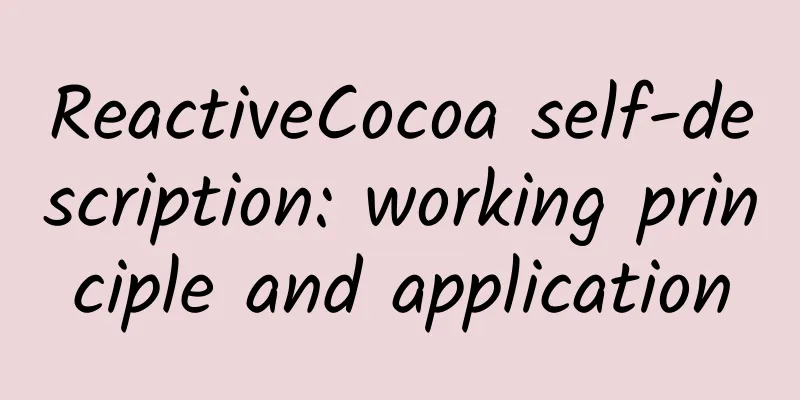ReactiveCocoa self-description: working principle and application

|
ReactiveCocoa (RAC) is an Objective-C framework inspired by functional reactive programming. If you are already familiar with functional reactive programming or know some of the basic premises of ReactiveCocoa, check out the Documentation folder for an overview of the framework, which contains some in-depth information about how it works. What is ReactiveCocoa? The ReactiveCocoa documentation is well written and covers in detail what RAC is and how it works. If you want to learn a little more, we recommend these resources: Introduction When to use ReactiveCocoa Framework Overview Basic Operators Header documentation Previously answered Stack Overflow questions and GitHub issues The rest of the Documentation folder Functional Reactive Programming on iOS(eBook) If you have any other questions, feel free to file an issue. file an issue. introduce ReactiveCocoa is inspired by functional responsive programming. Rather than using mutable variables which are replaced and modified in-place, RAC provides signals (expressed as RACSignal) to capture current and future values. By connecting, binding, and responding to signals, software can be written without having to continually observe and update values. For example, a text field can be bound to its latest state even as it changes, without having to write extra code to update the text field’s state every second. It’s a bit like KVO, but it uses blocks instead of overriding -observeValueForKeyPath:ofObject:change:context:. Signals can also represent asynchronous operations, a bit like futures and promises. This greatly simplifies asynchronous software, including network processing code. One of the main advantages of RAC is that it provides a single, unified approach to handling asynchronous behavior, including delegate methods, blocks callbacks, target-action mechanisms, notifications, and KVO. Here is a simple example:
Unlike KVO notifications, signals can be chained together and can operate simultaneously:
Signals can also be used to expose state. Instead of observing properties or setting other properties to reflect new values, RAC makes it possible to express properties through signals and operations :
Signals can be used in many places besides KVO. For example, they can also display button presses:
Or asynchronous network operations:
Signals can display timers, other UI events, or anything else related to time changes. For asynchronous operations using signals, more complex behaviors can be achieved by connecting and changing these signals. Work can be simply triggered when a set of operations completes:
Signals can execute asynchronous operations sequentially instead of nested block callbacks. This is very similar to futures and promises:
RAC can also easily bind the results of asynchronous operations:
This only describes what RAC can do, but it is difficult to explain why RAC is so powerful. Although it is difficult to explain RAC through this README, I will try to use less code, fewer templates, and better code to express it clearly. If you want more sample code, check out C-41 or GroceryList, which are real iOS apps written with ReactiveCocoa. For more information about RAC, see the Documentation folder. When to use ReactiveCocoa At first glance, ReactiveCocoa is very abstract, and it might be hard to understand how to apply it to a specific problem. Here are some common places where RAC is used. Handling asynchronous or event-driven data sources A lot of Cocoa programming focuses on responding to user events or changing application state. Writing code this way can quickly become a spaghetti-like mess with lots of callbacks and state variables. This pattern looks different on the surface, like UI callbacks, network responses, and KVO notifications, but actually has a lot in common. RACSignal unifies these APIs so that they can be combined and operated in the same way. Take the following code as an example:
…expressed in RAC like this:
Connection-dependent operations Dependencies are often used in network requests. When the next network request to the server needs to be built after the previous one is completed, you can look at the following code:
ReactiveCocoa makes this pattern particularly easy:
The above code can be easily cleaned up and optimized using synthetic signals:
Simplifying collection conversions Advanced features like map, filter, fold/reduce are sorely lacking in Foundation, leading to loop-heavy code like this:
RACSequence allows Cocoa collections to be manipulated in a unified way:
System requirements ReactiveCocoa requires OS X 10.8+ and iOS 8.0+. Introducing ReactiveCocoa To add RAC to your application: 1. Add the ReactiveCocoa repository as a submodule of your application repository. 2. Run script/bootstrap from the ReactiveCocoa folder. 3. Drag ReactiveCocoa.xcodeproj into your app’s Xcode project or workspace. 4. In the "Build Phases" tab of your application target, add RAC to "Link Binary With Libraries" On iOS, add libReactiveCocoa-iOS.a. On OS X, add ReactiveCocoa.framework. RAC must select "Copy Frameworks". If you don't have it, you need to select "Copy Files" and "Frameworks". 5. Add "$(BUILD_ROOT)/../IntermediateBuildFilesPath/UninstalledProducts/include" $(inherited) to "Header Search Paths" (this requires archive builds, but has no effect). 6. For iOS targets, add -ObjC to "Other Linker Flags" . 7. If you add RAC to a project (not a workspace), you need to add the appropriate RAC target to your application's "Target Dependencies". If you prefer to use CocoaPods, there are some generous third-party contributed ReactiveCocoa podspecs. To see a project using RAC, check out C-41 or GroceryList, which are real iOS apps written with ReactiveCocoa. Independent development If you are working with RAC in isolation rather than integrating it into another project, you will want to open ReactiveCocoa.xcworkspace instead of .xcodeproj. More information ReactiveCocoa is inspired by .NET's ReactiveExtensions (Rx). Some of the principles of Rx can also be used well in RAC. Here are some good Rx resources: Reactive Extensions MSDN entry Reactive Extensions for .NET Introduction Rx - Channel 9 videos Reactive Extensions wiki 101 Rx Samples Programming Reactive Extensions and LINQ RAC and Rx are both inspired by functional reactive programming. Here are some resources about FRP: What is FRP? - Elm Language What is Functional Reactive Programming - Stack Overflow Specification for a Functional Reactive Language - Stack Overflow Escape from Callback Hell Principles of Reactive Programming on Coursera |
<<: Android system has the largest market share, WP is still the third
>>: Is it really good to be a key player in a team?
Recommend
It can’t be removed even by boiling water, so beware of this type of food poisoning when it’s hot!
Review expert: Wang Guoyi, Postdoctoral Fellow in...
Huawei AppGallery keyword search bidding advertising is now online!
Huawei AppGallery launched the "Search Keywo...
Is global climate change causing the brain to become "out of control"?
Leviathan Press: In a previous article titled &qu...
Another addictive "Three Kingdoms" "Tower Three Kingdoms" first experience
Screen: operate: Sound Effects: Plot: Experience:...
All the strategies for advertising on new media platforms in 2018 are here!
According to the data from the "2018 China O...
In 2023, China's space program will accomplish these major tasks
In 2022, China's space industry experienced a...
101 years old! The world's oldest doctor reveals 5 secrets to longevity and anti-aging, which many people fail to follow
Imagine if you go to see a doctor and the doctor ...
World Economic Forum: 2023-2024 Fourth Industrial Revolution Network Center
The World Economic Forum has released its report ...
How to create a hit on Zhihu!
When it comes to creating high likes on Zhihu, th...
Good news from the Yangtze River "delivery room": this "mother" gave birth! The "baby" is so beautiful!
For many days in a row, a "great mother"...
Private domain operation, 90% of people ignore this point!
In user operations, refined operations can help o...
Copywriting methodology: 1 theme, 3 routines, 5 types and 4 psychological cognitions
Sometimes I wonder what the essence of copywritin...
Haibei teachers help children learn (family education)
Introduction to Haibei teachers’ resources for he...
Is it true that dogs can see all the colors in Bluey?
I heard that dogs all over the world are obsessed...
A gathering of young people with literary talents, Hammer has these three considerations
On the evening of the 19th, Hammer officially rel...









